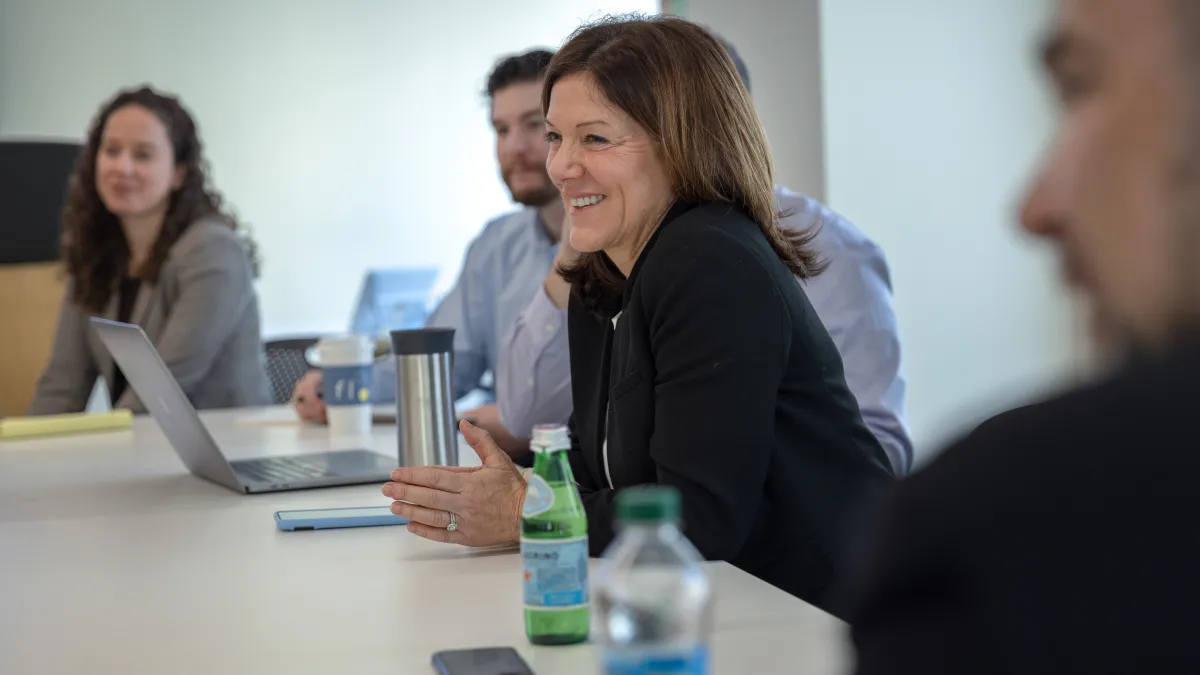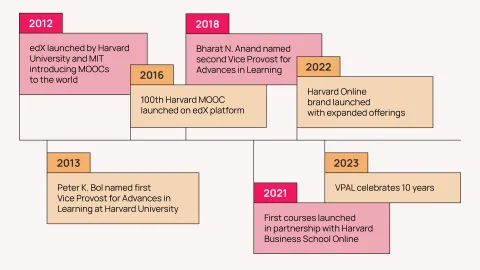Shaping the Future of Online Learning
Published May 22, 2024
If you’ve been enrolled in any educational course or postsecondary educational program since 2020, chances are you’ve witnessed the rise in online learning firsthand.
The COVID-19 global pandemic shuttered storefronts, theaters, and classrooms alike, causing major disruptions in how goods and services were delivered. As consumers adopted Instacart for their grocery needs and streamed new blockbuster movies from the comfort of their living rooms, students needed an innovative way to bring their classes home. A year into the pandemic over 60% of all undergraduate students were enrolled in at least one online course, with 28% exclusively enrolled in online courses, according to the National Center for Education Statistics.
There are other reasons for the widespread adoption, including accessibility. Rural and international students who may be far removed from traditional educational institutions can now attend Harvard classes anywhere there’s an internet connection. Or, consider working adults seeking to progress or switch careers. Life doesn’t stop for a class, and attending one in-person can be prohibitive. While still challenging, logging into a virtual classroom is far more manageable. Online education is for everyone.
Technological and pedagogical developments have helped online learning progress beyond the days of discussion boards and essay uploads. Now, students can enjoy a multimedia educational experience that is rooted in the latest research, all while participating in the community of their “virtual campus”.
If you’re one of the millions of learners who have experienced online education, you might be interested to learn where it’s going next. At Harvard Online, the question, “what is the future of online learning?” guides an ongoing conversation that drives us everyday.
In this blog, we sat down with Catherine Breen, Managing Director of Harvard Online. With more than two decades of senior executive leadership at Harvard University and oversight of Harvard Online, Breen has an invaluable perspective on the future of online learning, and the exciting role Harvard Online is playing in bringing the future into the present.

Catherine Breen, Managing Director of Harvard Online, in a team meeting.
Harvard Online (HO): How has the online learning landscape evolved in recent years?
Catherine Breen (CB): At the beginning of the COVID-19 lockdown, there was a massive escalation in demand for online learning. Demand began to recede slowly as the months wore on and by late 2022, it started to level out. But we observed two big changes:
Internally, the demand for Harvard Online content was still almost three times higher than pre-pandemic.
Externally, in reaction to the demand surge, there was significant and rapid growth of new online course offerings and companies that purveyed varying types of digital products.
HO: What is shaping the future of online learning today?
CB: Because of the rapid and massive shift to online that occurred around the globe in the spring of 2020, the landscape changed permanently. There are many things shaping the future but here are just a few that I can see from my perspective:
- Increased adoption of online learning across all ages and levels of education: Everyone expanded their online course catalogs; new companies and offerings sprung up everywhere.
- Greater tech investment across organizations and industries: Organizations are investing more time, money, and effort into technology infrastructure, tools, and platforms to support online learning and participants in these courses.
- New pedagogical methods to bridge the gap between traditional and novel learning methods: Instructors have adapted their teaching methods for online, hybrid, and blended environments.
- Enhanced accessibility to quality education and learning experiences: Efforts have been made to improve access for students of all types, abilities, geographies, and backgrounds so that everyone can participate effectively.
HO: What are the remaining challenges that online learning faces?
CB: While these changes have improved the online learning experience, challenges remain, including addressing the digital divide, maximizing student engagement, and refining the quality of online courses.
The pandemic accelerated the adoption of online learning and its impact will likely continue to shape higher education for many years to come.
HO: How does online learning contribute to Harvard's mission of promoting accessibility and inclusion in education, especially for learners who may not have traditional access to higher education?
CB: Online learning levels the playing field for learners in many ways.
Most students think that a Harvard-quality education is out of reach, for a variety of reasons. With online courses, however, learners from around the country and the world can take courses with Harvard instructors at their own pace at a more affordable price point.
Our online courses also typically incorporate a range of multimedia elements, allowing students with different learning styles to flourish. We also ensure that our online learning experiences are accessible to all learners, including those with disabilities. This commitment to inclusivity aligns with the broader goals of promoting equitable access to education.
Lastly, our online courses often include discussion forums and virtual communities where learners can connect and collaborate. This allows for interactions among students from diverse backgrounds and experiences, fostering a sense of belonging and inclusion.
It’s clear that online learning has a lot to offer everyone, and it’s only getting better. In our next blog in this series, we’ll hear more from Cathy on how institutions can implement online learning modalities effectively.
If you missed the first blog in this series detailing the future of online learning, you can check out the first blog here. To learn more about Harvard Online, explore our fully online course catalog here.
Related ArticlesA Decade of Innovation: Online Learning at Harvard We are always asking, “What does the future look like for teaching and learning?” Image

New Opportunities for Ibero-American Learners Image

|